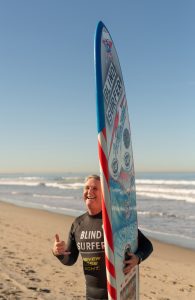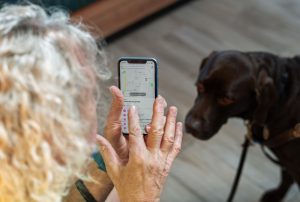People Profiles: Visually Impaired Surfer Gains Independence With Aid Of Apple Smartphone
FEATURE: 08.12.19- Surf’s up for the Summer and one visually impaired military veteran who has found a new pastime for himself is making waves by showing how Apple technology as simple as an iPhone assists with daily tasks like surfing the web, and not so everyday ones such as surfing the waters of the Pacific Ocean, proving that the blind (or those who have low vision) can live their lives as independently as any sighted individual can.
About the Series
- People Profiles is a special series that periodically appears here in the “Mac Potpourri” column on MacPrices which feature unique stories about users of Apple products (or related to the use of them in general)
- stories featured in this series are original (and in most cases exclusive to this column), however, from time to time, they may be derived from other sources, and, should this be the case, the source will be cited at the end of the story
- for more about People Profiles and its goal, primary focus, as well as the inspiration behind it, see this introduction to the series
(story continues after the break…)

SoCal surfer and wakeboarder Scott Leason (see related link to his biography) is usually up even before the sun has risen. By the time the clock strikes 5:30 in the morning, he already has read the news, checked his email and social media, and of course, the day’s weather on his recently purchased iPhone: the new XR model. Most importantly? Leason also has reviewed the surf reports for the day through an app called Surfline in order to get ready for his day out on the water. As an individual who is visually impaired, all of this is accomplished without any sight at all.
It has been 26 years since Leason lost his eyesight on Independence Day back in 1993 due to the bullet from the gun of a robber.
A veteran of the armed forces, Leason served seven years in the U.S. Navy aboard the USS Tripoli as a visual communications expert (or “signal man”), who would signal other ships with a Morse code-like series of flashing lights.
Leason would gain his own Independence Day of sorts when in 2009 — after eventually learning to live with his blindness — he received training in computers and technology from the blind rehabilitation center at the U.S. Department of Veterans Affairs, a move that was life changing and crucial to his independence.
Three years after that, Leason would get his first Apple smartphone with — the iPhone 5 — and would be trained at the Tibor Rubin VA Medical Center in Long Beach, California by Sarah Majidzadeh, assistant chief of Blind Rehabilitation at the center.
“These tools are leveling the playing field,” said Majidzadeh.
According to Apple, at the time, accessible mobile computer technology was nascent but iOS quickly was becoming a user favorite, and today, more people in the blind community now use VoiceOver than any other mobile screen-reading software combined. Roughly 70% of the veterans that have come through the 13 blind rehabilitation centers of the VA are provided with iOS devices which include accessibility training.
Leason is among a number of visually impaired people that depend on VoiceOver to perform day to day tasks.
“It’s a lot easier to navigate with the phone. I think a lot of the visually impaired prefer the iPhone because they can do everything on it. And VoiceOver works pretty darn good,” said Leason.
On a Friday late last year, Leason could be found headed off with his surfing gear in tow — in particular, with his custom Hank Warner surfboard which he purchased in 2015 specifically for competitions — to Mission Bay Aquatic Center in San Diego, California for a session of surfing at Mission Beach.
“When he showed me all the stuff he could do with [his iPhone], it just blew my mind that he had learned how to interact with it to get all of that out of it,” said Paul Lang, instructional coordinator at the Mission Bay Aquatic Center.
“The first time he got an iPhone and learned how to use VoiceOver, I asked him to show it to me because you just see him tapping the screen and to me it made no sense what he was doing ’cause it’s just like this flurry of tapping and these words coming out of the phone really really fast. …”
In addition to Leason’s skills on his iPhone, Lang (who already was working with Leason prior to him getting his iPhone 5 in 2012) also was amazed at his ability to adapt not only in the water but out of it as well.
“He’s no different than anybody else. He’s just sitting in the corner over there getting caught up on his phone or listening to music, reading, and sending text messages,” said Lang.
Through the past decade, the assistance of the Operation Rebound program for veterans from the Challenged Athletes Foundation has helped Leason — and the aquatic Center too — to adapt, learn, and grow while he tackles new accomplishments in the water.
“It’s amazing how long ago 10 years feels in the world of technology,” said Kevin Waldick, assistant director at the Mission Bay Aquatic Center.
“He was not very technologically savvy at all, but when he got his iPhone he was like ‘I can just do it. This is amazing.’ And so Apple does a really amazing job of making that accessible. These sports are accessible just like technology’s accessible. That’s been huge for him.”
Leason also has an Apple Watch Series 4 (see accessibility related article from this column) which he uses to track his workouts at home and while surfing in the water. Though Leason is pretty savvy with his iPhone XR, he’s not an Apple Genius. A characteristic he loves about his iOS devices is that they are all streamlined and just work, something the iPhone, in particular, does equally well for the sighted and the visually impaired alike.

“When I’m at the end of a line behind a boat just like anybody else, I forget I’m blind,” said Leason.
“And then when I come into the beach and there’s people around Snickers and I go yeah that’s my seeing eye dog and I got a board in my hand and they go, ‘you’re blind?’ That’s a cool feeling.”
Although Leason has worked with the Mission Bay Aquatic Center since 2008, riding the waves on his surfboard only came recently which was inspired from a hobby as a child during his younger years living in Corona Del Mar, a seaside neighborhood located in Orange County, 50 miles south of Los Angeles in the city of Newport Beach, California.
“The water sports are therapeutic but also I think it’s more of my identity and who I am, and who I grew up to be,” said Leason.
Aside from being a hobby, Leason loves to compete in water sports and strives hard to win, illustrating his athletic prowess in the ocean and to prove it? He has won a number of medals from competitions that he has participated in.
In the Summer of 2016, at the U.S.A. Adaptive Surfing Championships held at Oceanside Harbor North Jetty in Oceanside, California, he was its top contender, the first to win the competition as a visually impaired surfer. A few months later, he would win second place in the men’s tricks category at the U.S.A. Water Ski competition in Harmony, North Carolina.
Last year, Leason participated in four types of water sports and seven competitions.
Returning to the shore on this particular Friday following his session at Mission Beach, Leason, — with Snickers at his side, — enjoys his lunch and ponders his day of surfing on the water before heading back home to tackle another two hour workout ahead of him. Later, on his iPhone XR, Leason will update his GoFundMe page (see this related webpage) and also will organize his activity schedule for 2019. Most importantly? He will go on like any other sighted individual thanks to the help of accessible technology — like VoiceOver on his iPhone — from Apple.
“I’m independent. That’s the best way to describe the iPhone: independence,” said Leason.
A Note from the Author: This is the fourth edition of the People Profiles series here in the “Mac Potpourri” column. The subject of this story was not interviewed personally or directly by this writer (as is normally the case) and most of the information, if not all, herein was derived from the article: “Blind Veteran Catches Second Wave With A Surfboard And iPhone“. In addition, this story is one of a number of stories with Accessibility or disability related topics as its subject matter which this writer features periodically in this column due to his own disabilities (being visually impaired and partially hearing impaired) and, whenever the opportunity arises to share such stories, it is published here.
